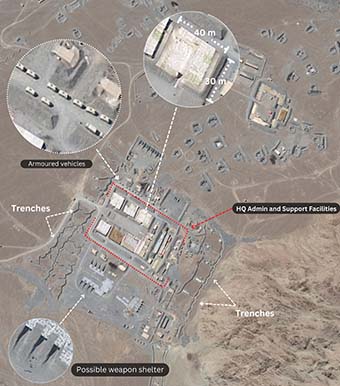
New Delhi: Even as tension continued along the Line of Actual Control (LAC) in Ladakh and troops of the two countries clashed near Tawang in Arunachal Pradesh on December 9, China has established a new-division level headquarters, equipped to support its forward deployment with troops, weapons, and air defence right along Pangong Lake.
In February 2021, India and China announced a mutually agreed pullback from the northern bank of the Pangong Tso (lake) in eastern Ladakh, where the two sides had been locked in an eye-to-eye confrontation for months. Both armies moved back to create a buffer zone following the 9th round of military talks.
The upcoming bridge will likely be supported by a network of roads being constructed at a rapid speed. India earlier blamed Beijing for hampering bilateral relations. China is now setting up what appears to be a new-division level headquarters, equipped to further support its forward deployment with troops, weapons and air defence right at the edge of the agreed pullback point, researchers at The Centre for Strategic and International Studies, a Washington D.C. based think tank have reported. Satellite images independently sourced by a media corroborate these findings and show that new structures continued showing up on the north bank as recently as last month, indicating ongoing expansion of infrastructure in the vicinity.
The large facility comprising multiple 40m X 30 m housing structures is supported by weapons shelters in the south and protected by trenches and weapons positions on the west. “On the south side are numerous shelters for weapons likely artillery and anti-aircraft systems. The northern portion shows a full company of armoured personnel carriers (APCs), as well as vehicle shelters and additional weapons positions,” CSIS, China Power contributors Matthew P. Funaiole, Brian Hart, Joseph S. Bermudez Jr., and Jennifer Jun observed.
Further analysis of the available satellite imagery puts the new HQ and garrison approximately 6.5 km from the friction point of 2020 at finger four of the lake. Though the most recent high-resolution imagery was available only until October of this year, low-resolution satellite pictures from mid-November show the emergence of a new mountaintop structure of unknown nature, approx. 3 km east of the garrison. Almost 2.5 km east of this location is an under-construction site with a Radome structure protecting radar, signal or similar antenna, that could be used for intelligence, communication or both. Further 10 km from the Radome is the steepest part of the lake reduces the distance between the north and the south banks. China has been constructing a wide two-decks bridge connecting the north and south banks at this very point.
What appeared to be temporary Chinese military encampments during the standoff through the year 2020, have been turned into a division-level headquarters and garrison, satellite pictures provided by Maxar Technologies suggest. While these structures are just at the edge of the agreed pullback location by the PLA, it is well within the territory claimed by India.
Construction work near the Radome site appeared to be still ongoing with two towers and a connecting road clearly visible in the satellite picture. A fortified large facility housing several armoured personnel carriers, troops, sheltered weapons and defence systems, improved intelligence and surveillance capabilities along with a transport network supported by new roads and a bridge over the lake make Chinese strategy and intents very clear in the region.
India earlier blamed Beijing for hampering bilateral relations asserting it will not tolerate unilateral attempts by China to change the status quo at the Line of Actual Control (LAC). “Diplomatically, we have been very clear with the Chinese – that we will not tolerate, we will not countenance unilateral attempts to change the LAC and that, so long as they continue to seek to do that and if they have built up forces, which in our minds constitute a serious concern in the border areas, then our relationship is not normal,” external affairs minister Dr S. Jaishankar told the parliament.








